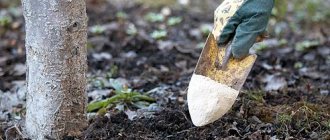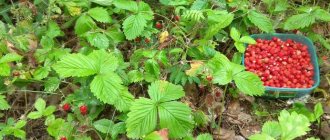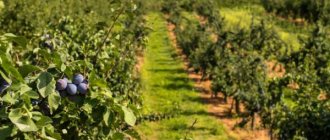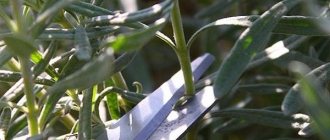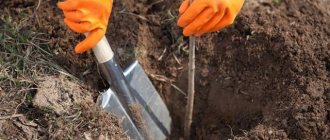Why are trees covered?
Nature has endowed apricot trees with poor resistance to cold and low temperatures. That is why it is especially important to cover plants for the winter in the northern and central regions of the country. Trees that grow in the southern regions are covered extremely rarely. Summer residents whose plots are located in the central and northern regions should not ignore this procedure. Shelter is considered the most important step in preparing a tree for the upcoming cold weather. The richness of the harvest depends on the quality of this procedure.
Features of overwintering apricot trees
The most destructive thing for apricots, regardless of their age, is the negative impact of winter thaws, which can provoke early biochemical processes. A sharp cold snap can cause irreversible damage, including the death of flower buds. Temperature changes are especially dangerous for young and newly planted fruit trees. In this regard, the question arises of how to properly insulate an apricot for the winter.
It is necessary to distinguish between the concepts of “winter hardiness” and “frost resistance”. The term “winter hardiness” refers to all the unfavorable factors of winter - winds, frosts, changes in humidity and temperature. The winter hardiness of the Apricot species, including its northern varieties, is still insufficient.
The concept of “frost resistance” is much narrower and means resistance to cold. In an ordinary apricot it is quite high. In the Volga region, apricot trees tolerate harsh winters quite well for many years.
The apricot's deep dormancy is quite short - until the beginning of December. All winter the trees are in a state of forced dormancy. This means that they are already capable of flowering and growing; only negative temperatures stop them from doing so. To start growth you need just a little heat. Even a thaw is enough for the apricot to begin to grow.
During the summer, fruit-bearing trees accumulate nutrients that are necessary for successful overwintering. Apricots in the south are covered with a “coat” of similar chemical compounds. In the middle zone, summers are moderately warm, so apricots do not have time to stock up on nutrients. They winter in a “light coat”.
It is worth noting the advantages of an early thaw. Apricot annually lays a large number of flower buds on annual shoots, regardless of the previous year's yield. If partial death of the buds did not sometimes occur, the tree would quickly become depleted and their lifespan would be shortened. This phenomenon is quite normal, this is the natural restoration of the apricot’s strength.
Preparatory work
Initially, gardeners and summer residents need to carry out preparatory work. To do this, you should fertilize the trees with phosphorus and potassium. It is also recommended to use a mixture consisting of crushed chalk and ash. The mass is classified as a mineral fertilizer that does not harm the plant.
Whitewashing is a stage that should also not be skipped when caring for apricots. By painting the trunk with a proven solution, summer residents eliminate the risk of insects breeding on the bark. As a rule, 2 kg of lime, 1 cup of paste and 200 g of copper sulfate are taken. The substances are mixed and tree trunks are whitened.
It is also important to properly prepare the crown of the plant. This contributes to the distribution of the flow of nutrients that occurs inside the tree. Thanks to proper pruning, the maximum amount of nutrients reaches the fertile branches.
In the fall, summer residents and gardeners carry out regulatory and formative pruning of apricot trees. If wounds remain after pruning or filing large branches, they are lubricated with copper sulfate, garden pitch or clay. All substances guarantee rapid healing of wounds on the trunk. If the putty falls off, but the wound does not heal, it is covered again.
Why does apricot need triple pruning?
In fact, the number of pruning procedures in autumn depends on the age of the tree; for the same reason, the need for this procedure is also distinguished:
- For young seedlings, pruning helps create the correct crown;
- old trees - provoke the growth of new young branches.
As practice shows, autumn pruning of apricots increases both the fertility of the tree and the quality of its fruit. If the tree is not pruned, then every year its fruits will become smaller and more sour.
Insulation technique
Gardeners often mulch the soil using 20cm layers of sawdust, straw, humus or hay. Then it’s a good idea to wrap the root collar with material that allows air to pass through. With such insulation, the root neck of the trunk will not support. Otherwise, the tree will not survive the winter cold well, and there will be a crop failure. As for the northern regions, it is best to cover the tree completely. A film is thrown over it. Its ends are secured to stakes, which are covered with earth.
Young seedlings
Frail and young seedlings are covered especially carefully and efficiently. The root system of such apricot trees is still poorly developed. This means that in severe frosts it can freeze very much. Sometimes the young plant dies. The branches and trunk love warmth, so it is important to cover the plant with burlap or similar material.
Old plantings
If old apricot trees grow in the middle zone, there is no need to insulate them. In such cases, only mulch is used to protect the root system from frost and snow. Also, such a shelter is needed to drain excess water from the roots. As for the northern regions, both old and young trees provide shelter here. Before covering old plantings, they are cut to 2.4–2.5 m in height.
When to cover an apricot before winter
The table below indicates when and under what weather conditions it is necessary to cover apricots, taking into account the temperature characteristics of different natural and economic regions.
| Region | Month | Average daily temperature | Weather |
| Moscow region | The beginning of November | -1 °C | Dry, fine, windless |
| Middle lane | November | 0 °C | Dry, fine, windless |
| Ural | End of october | -3°C | Dry, fine, windless |
| Siberia | End of october | -1 °C | Dry, fine, windless |
| Leningrad region | November | +4°C | Dry, fine, windless |
| Transbaikalia | The beginning of November | -6 °C | Dry, fine, windless |
| Far East | End of october | +5 °C | Dry, fine, windless |
| Khabarovsk | End of october | +3.5°C | Dry, fine, windless |
| Volga region | The beginning of November | +4 °C. | Dry, fine, windless |
Action plan
Growing a fruit tree does not require any special physical or material costs. Even a novice gardener can cope with this. In the fall, you need to carry out a number of care procedures that gradually adapt the tree to winter:
- Feeding. When the harvest is completely harvested, they begin fertilizing. For this purpose, mixtures containing phosphorus and potassium are used. Proponents of organic fertilizers use a mixture of crushed chalk and ash. Nitrogen compounds are excluded during this period, as they activate the life processes of the tree, as a result of which it will not be ready for the onset of frost.
- Whitewash. The procedure allows you to protect the apricot tree from attack by pests. To prepare whitewash, mix 2.5 kg of lime, 0.4 kg of copper sulfate and 1.5 cups of flour paste.
- Trimming. Before the onset of cold weather, formative, regulating and sanitary pruning is carried out. It is fundamentally important that the air temperature is not lower than 9 °C. Formative pruning of branches promotes uniform distribution of nutrients within the tree. The regulatory procedure allows you to “awaken” the growth of new branches. Sanitary pruning is characterized by the removal of damaged, dry and fungal-affected branches. After manipulation, the cut is treated with garden varnish to avoid infection.
Autumn feeding of apricot after fruiting
Immediately after the apricot harvest, i.e. Even in the second half of summer, it is advisable to feed apricot trees with phosphorus-potassium fertilizers (in no case nitrogen fertilizers such as urea or ammonium nitrate).
If you did not do this in the summer, then, of course, you can and should fertilize in the fall, for example, in September.
Most often, superphosphate and potassium sulfate , or simply potassium monophosphate (it is more expensive, but also more effective), or they buy ready-made special “autumn” (=phosphorus-potassium) fertilizers for the garden. Naturally, there is also an organic analogue - wood ash (potassium) and bone meal ( phosphorus ).
Important! As a rule, all fruit trees are fertilized approximately the same in the fall , so, for example, you can read this detailed article about autumn fertilizing of an apple tree .
By the way! All stone fruit crops take a lot of calcium from the soil to build their seeds , so it is very advisable to periodically feed apricots with calcium fertilizers , for example, calcium nitrate, dolomite flour (it also deoxidizes the soil). Moreover, they can be applied at any time - both in autumn and spring.
Video: how to feed apricots in the fall
Foliar feeding for better ripening of shoots
If at the beginning of autumn you see that the shoots of a young apricot planted this spring are still completely green , i.e. unripe and non-lignified (and such shoots simply cannot overwinter and will definitely freeze), then to speed up their ripening ( they should turn brown in winter ), you must carry out foliar feeding (spray the solution on the leaf) with phosphorus-potassium fertilizer (optimally - monopotassium phosphate ).
By the way! Summer chasing or pruning is also used to ripen apricot shoots . So, the length of young growth should not exceed 40-60 cm, everything else needs to be trimmed.
Wintering in the regions
To choose the right shelter for your garden pet, you need to take into account the weather conditions of the region. In central Russia, mulching the soil is sufficient for a favorable winter. In the Moscow region, where a sharp drop in temperature is possible, along with mulching, the tree is insulated with a special material. Volga region gardeners shorten the tree to 3 m and mulch with a thick layer of sawdust, straw or compost. After this, the trunk is wrapped with agrospan.
The methods of gardeners in Siberia and the Urals are very similar to the previous one, however, in addition to insulating the soil and the tree itself, they take care of water drainage. The fact is that when the snow melts, all the water is absorbed into the soil, which can cause rotting of the roots with subsequent rotting. Therefore, in order to avoid such an outcome, experienced summer residents first of all pave the way for the natural drainage of water.
Autumn care for a fruit tree does not require excessive effort. But inexperienced gardeners often make the following mistakes:
- Unscrupulous pruning, as a result of which “extra” branches remain on the tree: dry, spoiled, old and have not bear fruit for a long time.
- Insufficient and untimely shelter.
- Ignoring the construction of ways for water outflow. Relevant only for regions with snowy winters.
Apricot is a fruit that many people associate with summer. Grown with love and following basic standards, the fruits will become a real “lifesaver” for any housewife. Homemade apricots are a storehouse of beneficial properties. They are rich in potassium, phosphorus, magnesium, mineral salts, and a whole bunch of vitamins.
Regular consumption of fresh or dried fruits has a positive effect on vision, memory, blood vessels and, of course, taste buds.
Having a bucket of homemade fruits on hand, you can stock up on useful minerals and vitamins for the whole winter. Attention and responsible attitude towards garden plants guarantee a high-quality and generous harvest.
Instructions for proper pruning of apricots
Most often, gardeners use the following tree pruning methods:
- sparsely tiered;
- improved-tier;
- flattened
The sparse-tier method is characterized by the following execution algorithm:
- removal of the top by a quarter of the trunk length - in the first year after planting;
- leave a couple of shoots no larger than 30 cm in size;
- in the second year of growth, other shoots are shortened - no more than two, maintaining a distance of 40 cm between them;
- in the third year, the shoots on the central trunk are cut in half.
General rules for autumn care
With the arrival of autumn, the preparation of the garden for winter begins. First of all, plants are inspected for the presence of harmful insects and signs of fungal and bacterial infections. Trees and shrubs are treated with insecticides and fungicides. The trunk and skeletal branches of the apricot are covered with lime whitewash. Lime saves the plant from invasions of harmful insects and small rodents that feed on the bark of fruit crops in winter. At the next stage, moisture-recharging irrigation is carried out, which allows you to moisten the soil to a depth of 80–100 cm.
The application of potassium-phosphorus fertilizers helps enrich the soil with various nutrients and beneficial substances. Don't forget to mulch the soil around the tree trunk. A layer of mulch protects the fruit crop from temperature changes, cold and icing, and also allows the root to absorb moisture and “breathe”.
Autumn is considered the ideal period for sanitary pruning of the crown. Using garden pruners, remove all old and damaged branches. Young shoots are shortened so that the plant can be covered for the winter. But there should be several buds left on each branch.
Caring for apricots in the fall in preparation for winter
In the fall (September-October), sanitary pruning of the tree is carried out. The apricot crown is cleared of dried branches and shaped. Please note: in order for the cut areas to heal safely, the average air temperature must be above 8°C.
After leaf fall, the trees are treated with 3% Bordeaux mixture. This fungicidal agent will protect plants from fungal diseases. The trunk and skeletal branches are sprayed especially carefully.
In addition, to protect the tree from diseases and pests, the trunk is whitened with slaked lime with the addition of mullein or a special composition for whitewashing.
This is done in dry and cool weather.
If the autumn is unusually warm, fruit trees may experience long shoot growth. This causes freezing of not fully mature branches, flower buds and wood. To prevent this from happening, in August, apricots are generously watered with a solution of wood ash - 1 glass of the substance is diluted in 10 liters of water. About 6 buckets are used for an adult tree.
This procedure accelerates the ripening of shoots and stops their growth in the fall. It is also important to remove nitrogen fertilizers from the “diet” of apricot trees from the second half of summer.
Before the onset of stable cold weather, the tree trunk circle is mulched with peat, humus, compost or sand with the addition of sawdust. The mulch layer is about 20 cm.
How to insulate an apricot
Many novice gardeners believe that there is a standard scheme for insulating plants. However, this assumption is incorrect. Covering technology depends on the varietal characteristics and age of the cultivated crop, as well as on the climatic characteristics of the growing region. Next year's yield indicators depend on the preparation of fruit and vegetable crops for wintering.
What materials to use
Dry fallen leaves, sawdust, pine branches, shredded cardboard, straw and trimmings of covering material can be used as mulch. To insulate a fruit tree, lutrasil, agrofibre, polypropylene bags, burlap, thick cardboard, canvas and various non-woven materials are used. In severe frosts, the protective shelter is covered with dry soil or covered with spruce branches.
Tree covering technology
The algorithm for covering an apricot tree for the winter is as follows:
- Mulching the soil in the tree trunk circle with a layer of sawdust, fallen leaves and thin branches.
- Wrapping the trunk and skeletal branches of a fruit crop with burlap or thick non-woven fabric. Fixing the material with twine.
- Warming apricot with covering material.
- Installation of additional protection in the form of a wooden box or slate sheets during prolonged snowfalls and severe frosts.
How to save flower buds
A thaw in winter or early spring can destroy the entire crop. At this time, the buds wake up and even buds may appear. The first frost will kill them. Is it really impossible to protect a tree from the capricious nature? Of course you can. A reliable shelter can protect a delicate plant not only from frost. Under a blanket made of breathable fabric, a stable temperature is maintained. The sun's rays do not heat the branches, which means the apricot remains dormant until spring.
Features of insulation
Let's figure out how to cover young and old apricots growing in different climatic zones.
For young and old trees
A recently planted seedling that has not yet had time to adapt to the new area and climate needs special care. In order for a young tree to cope with the upcoming cold weather and recover with the arrival of spring, it needs to be carefully insulated. In severe frosts, a protective structure made of a metal or wooden frame with a polypropylene or canvas covering is put on the tree.
The protective structure must have openings for air circulation. The absence of such gaps leads to the accumulation of moisture inside, which is fraught with the appearance of fungus and mold on the wood.
It is not possible to insulate fruit trees aged 4 years and older so thoroughly. A layer of mulch in the tree trunk circle and a protective covering of the tree trunk will be sufficient. But this technology for insulating apricots is suitable for the Krasnodar Territory, Kuban, Crimea, Stavropol Territory and other regions of the country with warm winters.
In different regions
Winter in central Russia, including the Moscow region, is characterized by frequent changes in temperature conditions. An unexpected thaw may give way to a sharp cold snap and severe frosts, which is detrimental to fruit crops. You can avoid the death of a fruit tree with the help of a properly selected shelter - medium-density non-woven material is suitable.
In the Volga region, the Urals and Siberia, mature apricots are cut to a height of 2–2.5 m, mulched with sawdust, pine branches and straw. The crown of the tree is covered with agrofibre or lutrasil.
Despite the harsh climate and cold winters in Siberia and the Urals, apricot may die with the arrival of spring warmth. A sharp thaw is accompanied by an abundance of melt water. The root collar, which is constantly in water, begins to rot. For this reason, it is recommended to plant apricot at higher elevations.
Is it necessary to cover apricots for the winter?
Although apricot has ceased to be exotic, for abundant fruiting in regions with an unstable climate it must be covered.
Even winter-hardy varieties are difficult to tolerate: sharp temperature fluctuations, spring return frosts, cold drying winds, active solar exposure, and rodent attacks. The wood of an adult apricot can withstand frosts down to -35 degrees, but flower buds and twigs die with minor frosts. Young immature seedlings 100% need artificial shelter.


